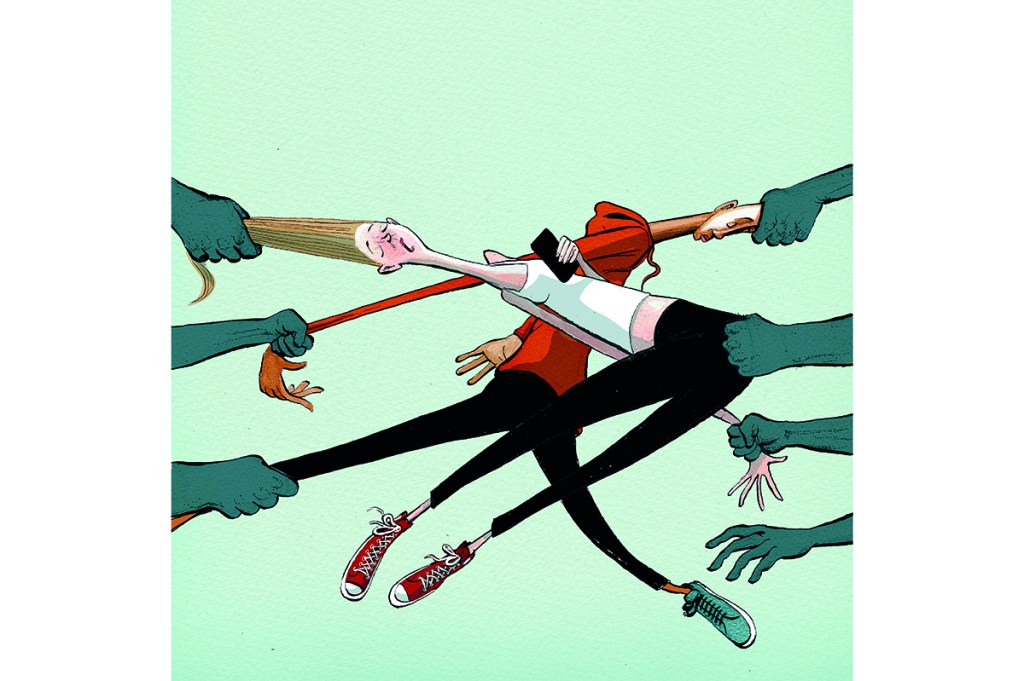The youth aren’t doing well — not in America, at least. Even before Covid, experts were ringing the alarm bells about a decade-or-so-long trend of American teens and tweens experiencing a steady uptick in anxiety, depression and self-harm symptoms.
Late last year, US surgeon general Dr. Vivek Murthy published an official advisory attempting to raise awareness of this issue. As the accompanying press release explained, “from 2009 to 2019, the share of high school students who reported persistent feelings of sadness or hopelessness increased by 40 percent, to more than one in three students. Suicidal behaviors among high school students also increased during the decade preceding Covid, with 19 percent seriously considering attempting suicide, a 36 percent increase from 2009 to 2019, and about 16 percent having made a suicide plan in the prior year, a 44 percent increase from 2009 to 2019.” Murthy described the situation as a “dual crisis” — the terrible impact of Covid layered atop an already dire youth-mental-health landscape.
The most viscerally upsetting presentation of the stats I’ve seen is a graphic representation of CDC data for emergency room visits for self-inflicted injuries among 10- to 19-year-olds. It shows a truly jarring and sudden uptick that started in 2009 — a terrifyingly steep line shooting up toward the heavens.
Both sexes are suffering, but the pain hasn’t been distributed equally between them. As the social psychologist Jonathan Haidt, who has written at length about this phenomenon, put it in testimony he submitted to a congressional subcommittee, “the base rate for mood disorders is always higher for girls than boys, particularly after puberty, which means that a doubling of the rate produces far more additional sick girls than boys… [and] there are some disorders and age groups for which girls are up far more, especially for self-harm, which is a much more common way of manifesting anxiety in girls than in boys.”
What’s going on, exactly? The short answer is that no one knows for sure. One possibility is that the 2008 financial crisis, a genuinely world-historical event, had some medium- and long-term effects. Think of the millions of kids raised in households hit with a sudden jolt of genuine, novel precarity — whether from a home foreclosure forcing a move, a parent losing a job or other factors — and then having to live with the aftermath. Researchers have believed for a long time that traumatic events suffered at a young age have a particularly brutal impact on young people’s wellbeing. It makes sound theoretical sense that the recession would leave an impact on the children hit hardest by it, and that the effects would linger for years. (Of course it left an impact on adults as well — by one 2013 estimate published in the British Medical Journal, the largest suicide rate increase in the Americas occurred among men aged 45-64, a group hard hit by layoffs and foreclosures.)
And not long after the recession, another world-historical development: the explosive rise of social media on mobile devices. Facebook accessed via a shared clunker of a desktop computer in the family room on dial-up is one thing; Facebook on a smartphone is quite another. Starting around 2010, teenagers were able to mainline information about their classmates, and to communicate with them 24/7, in a manner never before possible.
Researchers like Haidt believe that this can go a long way toward explaining the subsequent uptick in youth mental-health concerns. “A mean tweet doesn’t kill anyone; it is an attempt to shame or punish someone publicly while broadcasting one’s own virtue, brilliance, or tribal loyalties,” he wrote recently. “It’s more a dart than a bullet, causing pain but no fatalities. Even so, from 2009 to 2012, Facebook and Twitter passed out roughly 1 billion dart guns globally.” And Haidt thinks teenage girls are more particularly vulnerable to this dart warfare — more often on Instagram than Twitter, in their case — and that the effects on their mental health have been, in retrospect, predictable.
Last year, the Wall Street Journal got hold of internal documents from Meta, Instagram’s parent company, that revealed that the social media giant’s own research found that use of the platform was correlated with negative mental health outcomes among teenage girls. That being said, some scientists strongly disputed the strength of this data, in large part because it was premised so heavily on self-report from adolescents themselves.
One common view among many who lean on this explanation for the great mental-health decline is that it is driven by social comparisons: it’s unhealthy to constantly think about how other people are smarter or more attractive or more popular than you. Adolescents have a natural tendency to wallow in such thoughts, and social media offers what appears to be “evidence” to justify these dark ruminations about being less-than. It’s cherrypicked evidence, to be sure — most people go out of their way to publish posts and photos that make them look happy and fulfilled and successful and popular rather than the opposite — but to an adolescent brain desperate for validation and identity, it can be hard to cut through the fog. (The comedian Nathan Fielder once brilliantly pilloried the tendency toward this style of social media posting in a tweet of himself smiling, alone: “Out on the town having the time of my life with a bunch of friends. They’re all just out of frame, laughing too.” It went viral, I suspect, because so many people recognized that impulse in both themselves and others.)
There are other theories about the dark recent trajectory of youth mental health in the States — many of them a bit more ideologically motivated, I would argue, and less fully baked. Some conservatives argue there’s a link between unhappiness and the dissolution of traditional families, the rising age at which people get married and delayed (or eschewed) child-rearing. In this view, young people are becoming miserable because their lives are being evacuated of exactly those things that gave humans meaning and pride and structure in prior generations. For skeptics of “hook-up culture” (or whatever we’re calling it these days) who hold fairly traditional views of gender roles, this offers an easy explanation for why this epidemic is hitting girls harder: they’ve been sold a Tinderized bill of goods. Some leftists, on the other hand, blame things on capitalism’s bottomless rapaciousness. How could people not feel depressed and ground-down, they argue, given the rise of the gig economy, stagnant wages, inadequate healthcare and the near-total collapse of America’s mid-century social compact? (Some would agree with both these diagnoses.)
A lot of people believe we will, at some point, with enough data, be able to answer this question definitively. We won’t. Human society is too big and too complicated a machine; it effortlessly repels attempts at easy answers. Part of what’s interesting and frustrating is the extent to which our ability to answer questions about what is happening has outpaced our ability to answer why it is happening. We’ve made steady progress at being able to capture representative survey samples to get better and better data on — to take the present example — youth mental health. But we simply haven’t made much progress toward the much more complex goal of being able to explain the trajectories uncovered by all that number-crunching.
This leaves us in a Rorschachian space. In those areas where there’s at least arguably consensus about the what — and that’s the case here — a battleground will emerge for competing why explanations. We shouldn’t expect the most scientifically compelling ones to win out, necessarily. Instead, different groups will gravitate toward the explanations that reinforce their understandings of the world. It could be true both that the smartphone explosion is a credible driver of a lot of these distressing trends, and that we’re drawn to it less for scientific reasons than because, well, we all have a lot of gut-level hang-ups about our addictions to our phones.
All that said, there’s a difference between accepting the uncertainty here and pretending we know nothing about youth mental health and can’t offer any general guidance for concerned parents. We are, above all, a social species, and we’re most susceptible to despair — and to some mental health conditions — when we feel cut off from others.
Interestingly, the suicide rate didn’t go up during the first part of the pandemic (we have the best data from 2020) — it went down among all Americans and stayed flat among most younger cohorts. Some experts think that in at least some cases, the pandemic actually reduced certain stressors: it forced people to spend more time with family, away from abusive bosses. Of course, there’s such a thing as too much connection and closeness (ask any parents who survived the pandemic, or ask their teenage children), but American work life, with its long hours and punishing commutes, has often been marked by the opposite.
All of which offers some hints about what matters most in life: if kids spend a lot of time on their phones, but they also have strong real-life social ties (even ties that are reinforced via online communication), a supportive family and meaningful things to do in their free time, then all else being equal, they are statistically unlikely to be at a particularly high risk for anxiety, depression or suicide. What’s interesting about this is how intuitive it is: you probably didn’t need to read any fancy regression tables to know that this is the case. Sometimes — not always, but sometimes — our gut instincts are correct.
This article was originally published in The Spectator’s August 2022 World edition.


















